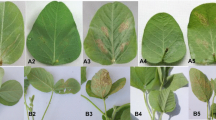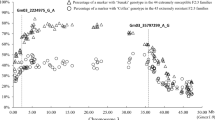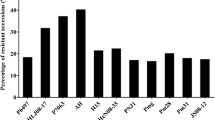Abstract
Asian rust, caused by the fungus Phakopsora pachyrhizi, is the most severe disease currently threatening soybean crops in Brazil. The development of resistant cultivars is a top priority. Genetic characterization of resistance genes is important for estimating the improvement when these genes are introduced into soybean plants and for planning breeding strategies against this disease. Here, we infected an F2 population of 140 plants derived from a cross between ‘An-76’, a line carrying two resistance genes (Rpp2 and Rpp4), and ‘Kinoshita’, a cultivar carrying Rpp5, with a Brazilian rust population. We scored six characters of rust resistance (lesion color [LC], frequency of lesions having uredinia [%LU], number of uredinia per lesion [NoU], frequency of open uredinia [%OU], sporulation level [SL], and incubation period [IP]) to identify the genetic contributions of the three genes to these characters. Furthermore, we selected genotypes carrying these three loci in homozygosis by marker-assisted selection and evaluated their genetic effect in comparison with their ancestors, An-76, PI230970, PI459025, Kinoshita and BRS184. All three genes contributed to the phenotypes of these characters in F2 population and when pyramided, they significantly contributed to increase the resistance in comparison to their ancestors. Rpp2, previously reported as being defeated by the same rust population, showed a large contribution to resistance, and its resistance allele seemed to be recessive. Rpp5 had the largest contribution among the three genes, especially to SL and NoU. Only Rpp5 showed a significant contribution to LC. No QTLs for IP were detected in the regions of the three genes. We consider that these genes could contribute differently to resistance to soybean rust, and that genetic background plays an important role in Rpp2 activity. All three loci together worked additively to increase resistance when they were pyramided in a single genotype indicating that the pyramiding strategy is one good breeding strategy to increase soybean rust resistance.




Similar content being viewed by others
References
Arias CAA, Toledo JFF, Almeida LA et al (2008) Asian rust in Brazil: varietal resistance. In: Kudo H et al (eds) JIRCAS working rep no. 58: facing the challenge of soybean rust in South America. Japan International Research Center for Agricultural Sciences (JIRCAS), Tsukuba, pp 29–30
Bonde MR, Nester SE, Austin CN, Stone CL, Frederick RD, Hartman GL, Miles MR (2006) Evaluation of virulence of Phakopsora pachyrhizi and P. meibomiae isolates. Plant Dis 90:708–716
Bromfield KR, Hartwig EE (1980) Resistance to soybean rust and mode of inheritance. Crop Sci 20:254–255
Castro AJ, Chen X, Hayes PM, Johnston M (2003) Pyramiding quantitative trait locus (QTL) alleles determining resistance to barley stripe rust: effects on resistance at the seedling stage. Crop Sci 43:651–659
Collard BCY, Mackill DJ (2008) Marker-assisted selection: an approach for precision plant breeding in the twenty-first century. Phil Trans R Soc B 363:557–572
Cregan PB, Jarvik T, Bush AL et al (1999) An integrated genetic linkage map of the soybean genome. Crop Sci 39:1464–1490
Draper NR, Smith H (1966) Applied regression analysis. Wiley, New York
Fehr WR, Caviness CE, Burnood DT, Pennington JS (1971) Stage of development descriptions for soybeans, Glycine max (L.) Merril. Crop Sci 11:929–931
Garcia A, Calvo ES, Kiihl RAS, Haranda A, Hiromoto DM, Vieira LGE (2008) Molecular mapping of soybean rust (Phakopsora pachyrhizi) resistance genes: discovery of a novel locus and alleles. Theor Appl Genet 117:545–553
Garcia A, Calvo ES, Kiihl RAS, Souto ER (2011) Evidence of a susceptible allele inverting the dominance of rust resistance in soybean. Crop Sci 51:32–40
Grant D, Nelson RT, Cannon SB, Shoemaker RC (2010) SoyBase, the USDA-ARS soybean genetics and genomics database. Nucleic Acids Res 38:843–846
Hartwig EE (1986) Identification of a 4th major gene conferring resistance to soybean rust. Crop Sci 26:1135–1136
Hartwig EE, Bromfield KR (1983) Relationships among 3 genes conferring specific resistance to rust in soybeans. Crop Sci 23:237–239
Hwang TY, Sayama T, Takahashi M et al (2009) High-density integrated linkage map based on SSR markers in soybean. DNA Res 16:213–225
Hyten DL, Hartman GL, Nelson RL et al (2007) Map location of the Rpp1 locus that confers resistance to soybean rust in soybean. Crop Sci 47:837–840
Hyten DL, Smith JR, Frederick RD, Tucker ML, Song Q, Cregan PB (2009) Bulked segregant analysis using the GoldenGate assay to locate the Rpp3 locus that confers resistance to soybean rust in soybean. Crop Sci 49:265–271
Kato M, Yorinori JT (2008) A study on race composition of Phakopsora pachyrhizi in Brazil: a difficulty of race identification. In: Kudo H et al (eds) JIRCAS working rep no. 58: facing the challenge of soybean rust in South America. Japan International Research Center for Agricultural Sciences (JIRCAS), Tsukuba, pp 94–98
Kolmer JA (1996) Genetics of resistance to wheat leaf rust. Annu Rev Phytopathol 34:435–455
Kolmer JA, Dyck PL (1994) Gene expression in the Triticum aestivum–Puccinia recondita f. sp. tritici gene-for-gene system. Am Phytopathol Soc 84:437–440
Lander ES, Green P, Abrahamson J, Barlow A, Daly JM, Lincoln SE, Newberg L (1987) Mapmaker: an interactive computer package for constructing primary genetic linkage maps of experimental and natural populations. Genomics 1:174–181
Li ZK, Sanchez A, Angeles E, Singh S, Domingo J, Huang N, Khush GS (2001) Are the dominant and recessive plant disease resistance genes similar?. A case study of rice R genes and Xanthomonas oryzae pv. oryzae races. Genetics 159:757–765
Liu J, Liu D, Tao W, Li W, Wang S, Chen P et al (2000) Molecular marker-facilitated pyramiding of different genes for powdery mildew resistance in wheat. Plant Breed 119:21–24
McLean RJ, Byth DE (1980) Inheritance of resistance to rust (Phakopsora pachyrhizi) in soybeans. Aust J Agric Res 31:951–956
Monteros MJ, Missaoui AM, Phillips DV, Walker DR, Boerma H (2007) Mapping and confirmation of the ‘Hyuuga’ red-brown lesion resistance gene for Asian soybean rust. Crop Sci 47:829–836
Morel PW (2001) Roya de la Soja. Comunicado Técnico – Reporte Oficial, Serie Fitopatología, 1, Junio. Ministerio de Agricultura y Ganadería, Subsecretaria de Agricultura, Dirección de Investigación Agrícola, Centro Regional de Investigación Agrícola – CRIA, Capitán Miranda, Itapúa, Paraguay
Moury B, Morel C, Johansen E et al (2004) Mutations in potato virus Y genome-linked protein determine virulence toward recessive resistances in Capsicum annuum and Lycopersicum hirsutum. Mol Plant–Microbe Interact 17:322–329
Murray MG, Thompson (1980) Rapid isolation of high molecular weight plant DNA. Nucleic Acids Res 8:4321–4325
Palloix A, Ayme V and Moury B (2009) Durability of plant major resistance genes to pathogens depends on the genetic background, experimental evidence and consequences for breeding strategies. New Phytol 183:190–199
Pierozzi PHB, Ribeiro AS, Moreira JUV et al (2008) New soybean (Glycine max Fabales, Fabaceae) sources of qualitative genetic resistance to Asian soybean rust caused by Phakopsora pachyrhizi (Uredinales, Phakopsoraceae). Gen Mol Biol 31(2):505–511
SAS INSTITUTE (2008) SAS/STAT user’s guide: statistics. Version 9.2. SAS Institute,Cary
Sato S, Isobe S, Asamizu E et al (2005) Comprehensive structural analysis of the genome of red clover (Trifolium pratense L.). DNA Res 12:301–364
Shi A, Chen P, Li D, Zheng C, Zhang B, Hou A (2009) Pyramiding multiple genes for resistance to soybean mosaic virus in soybean using molecular markers. Mol Breed 23:113–124
Silva DCG, Yamanaka N, Brogin RL et al (2008) Molecular mapping of two loci that confer resistance to Asian rust in soybean. Theor Appl Genet 117:57–63
Singh S, Sidhu JS, Huang N, Vikal NY, Li Z, Brar DS et al (2001) Pyramiding three bacterial blight resistance genes (xa5, xa13, Xa21) using marker-assisted selection into indica rice cultivar PR106. Theor Appl Genet 102:1011–1015
Soares RM (2008) Practical soybean rust identification. In: Kudo H et al (eds) JIRCAS working rep no. 58: facing the challenge of soybean rust in South America. Japan International Research Center for Agricultural Sciences (JIRCAS), Tsukuba, pp 66–69
Song QJ, Marek LF, Shoemaker RC, Lark KG, Concibido VC, Delannay X, Specht JE, Cregan PB (2004) A new integrated genetic linkage map of the soybean. Theor Appl Genet 109:122–128
Wang S, Basten CJ, Zeng ZB (2007) Windows QTL Cartographer 2.5 Department of Statistics, North Carolina State University, Raleigh, NC, USA. http://statgen.ncsu.edu/qtlcart/WQTLCart.htm. Accessed 20 July 2009
Yamanaka N, Silva DCG, Passianotto AL et al (2008) Identification of DNA markers and characterization of the genes for resistance against Asian soybean rust. In: Kudo H et al (eds) JIRCAS working rep no. 58: facing the challenge of soybean rust in South America. Japan International Research Center for Agricultural Sciences (JIRCAS), Tsukuba, pp 99–107
Yamanaka N, Yamaoka Y, Kato M et al (2010) Development of classification criteria for resistance to soybean rust and differences in virulence among Japanese and Brazilian rust populations. Trop Plant Pathol 35:153–162
Yorinori JT (2008) Soybean germplasms with resistance and tolerance to Asian rust and screening methods. In: Kudo H et al (eds) JIRCAS working rep no. 58: facing the challenge of soybean rust in South America. Japan International Research Center for Agricultural Sciences (JIRCAS), Tsukuba, pp 70–87
Acknowledgments
The authors thank Ms. Akiko Takahashi and Ms. Tomomi Mori, JIRCAS, for their assistance in this work. This study was supported by a JIRCAS international project, “Identification of Stable Resistance to Soybean Rust for South America.”
Author information
Authors and Affiliations
Corresponding author
Rights and permissions
About this article
Cite this article
Lemos, N.G., de Lucca e Braccini, A., Abdelnoor, R.V. et al. Characterization of genes Rpp2, Rpp4, and Rpp5 for resistance to soybean rust. Euphytica 182, 53–64 (2011). https://doi.org/10.1007/s10681-011-0465-3
Received:
Accepted:
Published:
Issue Date:
DOI: https://doi.org/10.1007/s10681-011-0465-3




